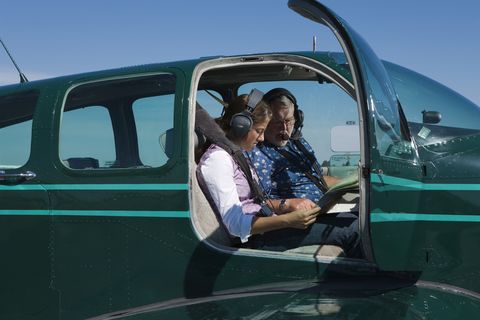Earn your pilot’s license on a budget in five simple steps.
Is anything more human than the pursuit of flight? Perhaps attaching a ludicrous price tag to the venture is quite human, too, but it doesn’t have to be this way. Sure, learning how to fly a plane is going to cost you, but with a bit of gumption, you can create a budget that’s more akin to what an avid golfer spends on tee time than some absolutely out-of-reach pastime for the ultra rich.
I earned my pilot’s certificate as a teenager more than two decades ago, ultimately leading to a career in aviation. Here are five tips you can employ to help keep your flight-learning costs from soaring higher than a Cessna.Skip Flight School
 Karen Moskowitz//Getty Images
Karen Moskowitz//Getty ImagesIt’s a common mantra in aviation that the only way to learn how to fly is to go to flight school. While a large flight school may offer a standardized curriculum and potentially lower rates, there are disadvantages, too.
In the last decade or so, airlines have had to look beyond the military for pilots to fill their increasing cockpit vacancies. This has put flight schools into the big business of manufacturing career airline pilots. Recent federal regulations also require new airline pilots to have substantially more flying experience. This trend isn’t great for anybody who just wants to learn to fly recreationally, though, and doesn’t need to rack up all the hours that potential airline pilots need.
A freelance flight instructor can help you come up with an individualized training plan at a lower price. A dedicated flight instructor will not be held to a strict training outline and will be flexible to your learning abilities and budget. And an independent instructor will typically teach you in any aircraft you choose.
It may require some legwork to locate a qualified trainer near you. Checking your local airport office for classifieds is a great way to connect with an independent instructor. Many airports also offer a community open-house or pancake breakfast to encourage interest in flying. Also, aviation is a pretty tight community. If you happen to know a pilot, chances are they can recommend someone great.Do Some Studying on Your Own
 VW Pics//Getty Images
VW Pics//Getty ImagesA lot of flight training happens on the ground. In fact, at the conclusion of your training, you’ll be tested in three phases, and only one of those will demonstrate your flying capabilities. The other two consist of a multiple-choice written test and an oral exam conducted by either a Federal Aviation Administration (FAA) official or a designated pilot examiner.
While we’ve absorbed the rules of the road since we were kids, riding around and watching our parents drive, flying concepts are much more foreign to any new student. To learn how to fly an aircraft requires an extraordinary amount of book knowledge.
The most popular (and expensive) way is to pay a personal flight instructor. But unless your note-taking is superb, much of the teaching is impossible to use for review and study later. Plus, you’re paying a professional pilot for hourly lessons.
You can also try a weekend ground school. This is typically a lecture class taught by an instructor over several days. The ground school is a more expensive option but only focuses on the written exam. It can also be less personal and may not cover personal gaps in knowledge.
A third option is a self-study course that involves some textbooks and informal training material, or an online ground school that can be reviewed multiple times. Many aviation education companies offer an all-in-one solution for online knowledge training and some even guarantee you’ll pass all three portions of your flight test or you get a full refund.Go With a Sport Pilot Certificate
 VW Pics//Getty Images
VW Pics//Getty ImagesThe Sport Pilot certificate was created in 2004 to offer an affordable entry into aviation. Compared to the typical Private Pilot certificate, applicants receive the same privileges, but are restricted to a lighter two-seat aircraft. The flight hour requirement is also cut to only 20 hours, and a Sport Pilot can still make flights across the county but only during the day.
Though these airplanes are generally smaller than the traditional training aircraft of the past half century, they travel at comparable speeds, carry similar amounts of cargo, and generally burn much less fuel. The efficient fuel burn and typically lower operating cost also translate to cheaper rentals. And since the Sport Pilot category is barely a decade old, you won’t be training in an old Cessna held together by duct tape and good intentions.
 Portra//Getty Images
Portra//Getty ImagesAlthough you may be tempted to pack your flight training into the weekends, the weeklong sabbaticals in between can wreak havoc on your learning retention. Over the many hours needed to earn a pilot certificate, added time for review adds up to a costly redundancy that could be avoided by a persistent training schedule.
A dedicated two, three, or even four weeks of open schedule will create an enormous cost savings. This may be the most difficult but potentially best money-saving tip out there. Even taking unpaid vacation time from your career has the opportunity to save you more on your training than what you would lose in wages.Buy Your Own Plane
 Portland Press Herald//Getty Images
Portland Press Herald//Getty ImagesOkay, hear me out. Let’s say you’ve got enough cash to consider buying a plane for training purposes. There’s a good chance you could save cash this way.
With new aircraft prices soaring, the used market is strong and you can find great deals. With resale values holding steady, you can accurately calculate the expected depreciation of a plane and sell it for nearly what you paid for it once you finish flight training (you should check out this advice from the Aircraft Owners and Pilots Association before buying a used aircraft).
You can also buy your own fuel instead of paying the bundled hourly rate. Other costs—like hangar or storage fees and insurance—are predictable, and a total of all expenses needed to complete your training should allow for a very accurate budget. Compare this price to the hourly rate at your local airplane rental, and there’s a good chance you’ll see several thousand dollars in savings.
Of course, there are risks. Maintenance could throw off your budget, and unforeseen aircraft market changes could affect your resale. You also may not have tens of thousands of dollars stashed away. Not too many mega banks offers aircraft financing, either.
If buying your own aircraft isn’t possible, maybe it’s time to find some friends to share those costs. Flying clubs are a popular option for making aircraft ownership possible with an upfront fee that buys you a portion of one or multiple aircraft. Monthly dues go toward maintenance, insurance, and hangar fees. These clubs can be as informal as a small group of pilots who each split duties for keeping the club running or an organization with a small fleet of airplanes and many members. If you chose this route, just be sure to verify the penalties in the event you decide to sell your share and leave the club.
Really, the one thing an aspiring pilot needs above all else is dedication, both when researching cost options or studying for a pilot’s license. If you have that, learning how to fly is remarkably within reach.






